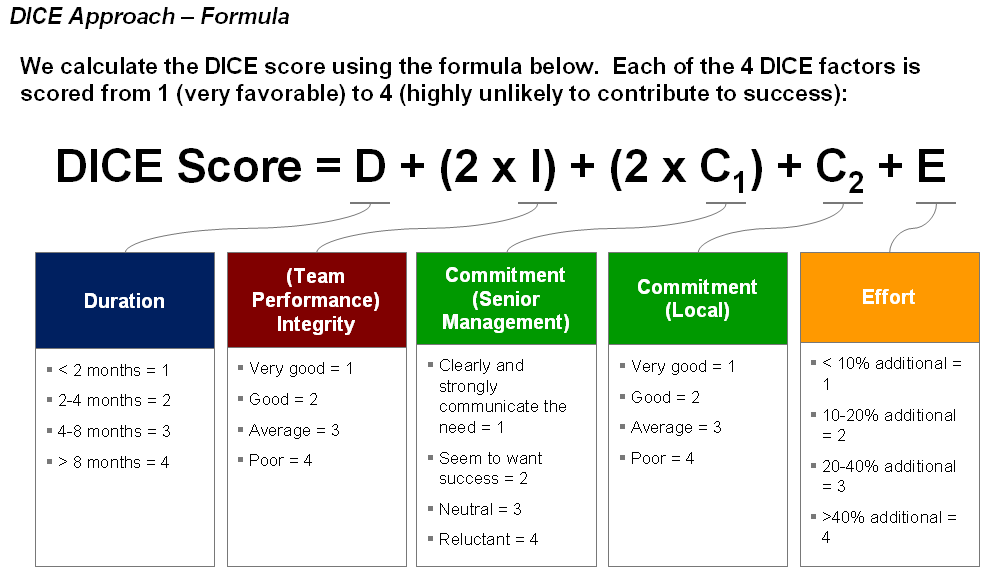DICE Framework
DICE Framework
Dr. Abdulrahman ALJAMOUSS
Idea in short
In the past 50 years, thousands of books have been written about change management. Change management is hard and extremely complex. No two change initiatives having the same factors at play. In recent years, many of these books have focused on the soft factors, such as such as communication, employee motivation, visionary leadership, etc. that affect the outcome of a change initiative. According to Boston Consulting Group found through research While these soft factors play an important role on change initiatives, is that it is the hard factors where management should focus most. Essentially, if you don’t pay attention to the hard factors then the soft factors won’t get the chance to raise their head as issues to address in the first place.
DICE framework helps calculate how well a company is implementing its change initiatives or how well it can implement its change initiatives. It helps companies appraise whether certain change initiatives will be successful or are doomed to failure from the onset.
DICE framework
According to a HBR article by Harold L. Sirkin, Perry Keenan and Alan Jackson from BCG, soft factors that influence the success of a change program include: vision, leadership, organizational culture, employee motivation, top-down or participatory approach. But there are a number of hard factors that do not receive the attention that they deserve. These hard DICE Factors are:
- Duration: This is the length of time until the change program is completed. For longer initiatives, this is the amount of time between milestone reviews. According to BCG, a long project that’s reviewed frequently is more likely to succeed than a short project that isn’t reviewed frequently
- Integrity: The project team’s ability to successfully complete the change project on time. This factor evaluates the project team’s ability, based on skills and traits of people on the team, and how the project configuration. According to BCG, the success of change programs depends significantly on the quality of teams. Companies do well assigning their best people to the change efforts
- C: Commitment
- C1: Backing from the most influential executives (often, but not necessarily top management)
- C2: Lack of support from employees impacted by the change
- Effort: How much work does the change initiative requires above the regular workload of employees. Project teams must calculate how much work employees will have to do beyond their existing responsibilities to change over to new processes. Ideally, no one’s workload should increase more than 10%.
One advantage of the hard factors is that you can easily measure them, either directly or indirectly. Because these factors can easily be measured, they are relatively simple to influence. By measuring and then impacting positively the hard factors, organizations can increase the chances of project success.
DICE formula
Using a set of simple questions, give each factor a score from 1 (very favorable) to 4 (highly unlikely to contribute to success). Next, calculate the DICE score by applying the following formula:
DICE Score = D + (2 x I) + (2 x C1) +C2 + E.
DICE Calculator:
https://dice.bcg.com/dice-calculator/ 
First, score each factor between 1 and 4. Use fractions, if appropriate. This means C1 and C2 must total 4, maximum. Second, note the emphasis on team Integrity and management Commitment. The DICE formula weighs both these by 2.
Overall, the lower the score the more likely the project is to succeed. 7 is the best possible score. 28 the worst. Projects between:
- 7 to 14 are in the Win Zone and are very likely to succeed
- 14 and 17 in the Worry Zone are risky
- Scores over 17 are in the Woe Zone and are very risky
Each DICE Project Score will fall within one of the following three buckets:
Win
- Initiatives with scores between 7 and 13 are very likely to be successful and considered to be in the Win zone
Worry
Initiatives with scores between 14 and 17 are in the Worry zone. You should take action to move them to the win zone
Woe
Initiatives with scores between 18 and 24 are in the Woe zone. These projects are very risky and highly likely to fail. Hence, you should take strong action to address the four influencing hard factors immediately to increase the likelihood of success.
Advantages
- Hard factors can easily be measured, communicated and influenced
- Enables communication
- Standard way of determining project feasibility.
- Using a framework helps managers to evaluate projects consciously
Disadvantages
- Determining the scores is a subjective process
- The method does not deal with the soft change factors, although they are important
